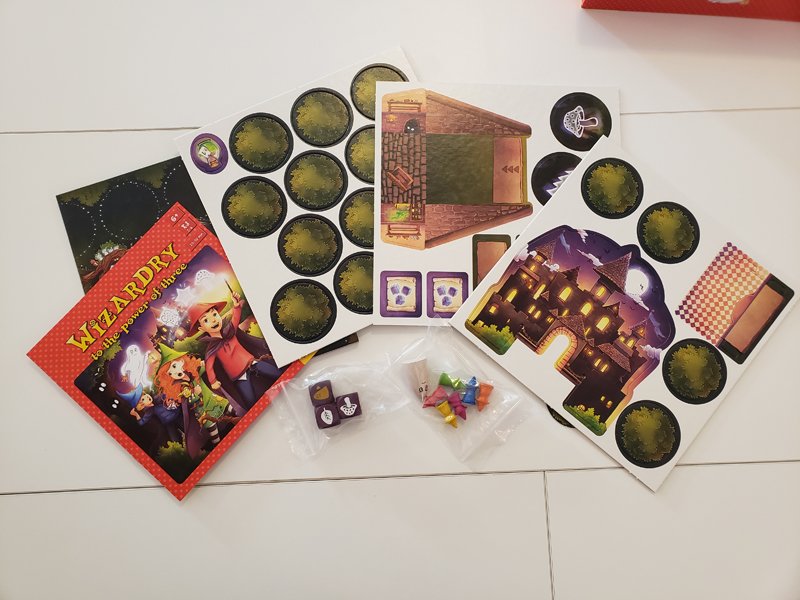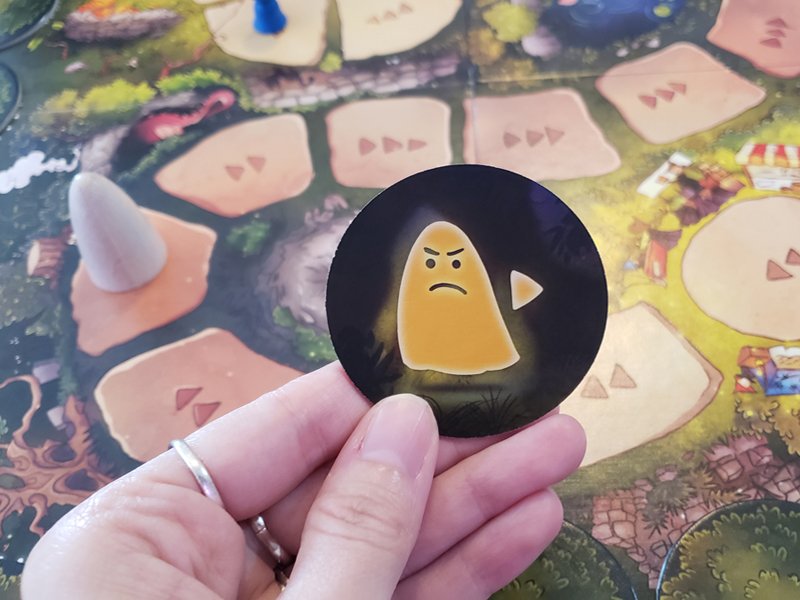
Since becoming a parent of two, I have gained a certain appreciation for cooperative style board games for our boys A and W (ages 8 and 5), especially when I can find the ones easy enough for W to play but still engaging enough for A. Pegasus Spiele released their cooperative game Wizardry to the Power of Three at Gen Con 2019, and we were lucky enough to receive a copy in exchange for a review.
What Is Wizardry to the Power of Three?
Wizardry to the Power of Three is a cooperative memory-based board game for 2-6 players ages 6+ and takes about 20-30 minutes to play. It has an MSRP of $29.99.
Wizardry to the Power of Three Components

Wizardry to the Power of Three contains the following:
- 1 Game Board
- 1 Wizard School with Staircase
- 6 Wizard Students in 6 colors
- 1 Willy the Warden Ghost
- 1 Ghost Clock
- 18 Tree Tiles (16 Lumies and 2 Ghosts)
- 3 Dice
- 3 Magic Potions
- 3 Dice Enchantments
- 1 Instruction Booklet
I love how the little Wizard Students, Willy the Warden Ghost, and the dice are all made of wood. The game board is solid cardboard, as are the rest of the game pieces. My only quibble is with the staircase. It is meant to be assembled one time, but the lower step pieces seem prone to sliding out, since the slots are pretty narrow and the stair doesn’t have much of an edge to go in. If you’re not careful, you or one of your kids can start separating the cardboard at the edges if you try to jam it back together too hard. You might find that a little glue helps to keep this secure. Otherwise, the pieces are all great.
How to Play Wizardry to the Power of Three
The Goal
The goal of Wizardry to the Power of Three is to get all of the players’ Wizard Students into the castle before Willy the Warden Ghost can catch any of them. Players will have to cooperatively use their memory skills to recall where the different “Lumies” are to help guide each other back to the Wizard School.
Setup

Setup is pretty fast and straightforward, which I appreciate in any game aimed at kids. The first time it comes out, the cardboard pieces need to be popped out of their sheets and an adult should assemble the staircase because jamming the stairs too hard can separate the cardboard. Otherwise, kids should be able to put the game together on their own. The Wizard School and Staircase get placed next to the bricks on the board. Willy the Warden Ghost goes at the opposite end on the space with a little ghost icon. The circular spot on the board is where the Wizard Students start (6 places in front of Willy). The 18 Tree Tiles are randomly placed on the circle spots around the game board (no peeking quite yet!). Next, decide the difficulty level of the game. For Beginner mode, you get all 3 Magic Potions and 3 Dice Enchantments, for Advanced 2 of each, and for Hard 1 of each. The Player who has spent the most time in forests goes first and gets the Ghost Clock. You are now ready to play.
Gameplay
The game starts with each player secretly getting to peek at one tile and putting it back. If you find a Ghost, show the other players and move Willy forward one. Now start with Player One (going forward play will go clockwise to each player in turn).
Dice Rolls
On their turn, the Player who is up rolls all three dice. The dice will either show a Lumie to look for, a Ghost (move Willy forward 1 space at the end of your turn), or a potion that lets you automatically move up one space.
Searching for Lumies

The Player who is up will flip over a tile to try to discover a Lumie, which is a little image or an animal or object. The other players are allowed to help and give hints. If you find a Lumie, you can keep trying to flip over more tiles until you have found all of your Lumies, found an incorrect Lumie, or found a Ghost. Move your Wizard Student forward once for every correct Lumie you found. If you find an incorrect Lumie, your turn ends (you can still move one space forward for any correct Lumies you found before the wrong one). If you find a Ghost your turn also ends, but for every previous correct Lumie you found, Willy moves forward as well as your Wizard Student.

Magic Potions and Dice Enchantments
If Willy gets too close, you might use a Magic Potion to move yourself or another player forward a space. A Dice Enchantment can be used to reroll all of the dice. Once used, these items are removed from the game.
End of the Round
Every time the play comes back around to the first player, the Ghost Clock should remind you that Willy gets to move as many spaces as there are arrows on his current spot. He moves before your dice rolling.
On the Stairs

Once you reach the steps, you may not get help from other players. If you get inside the Wizard School, you are safe from Willy, but you can still help any players not on the stairs.
Game End
The game ends when all your Wizard Students are safely in the Wizard School, in which case you all win. If Willy the Warden Ghost catches any student, the whole team looses, however. Cooperation is key.
Why You Should Play Wizardry to the Power of Three
Overall, it’s a solid game with good rules and solid enough pieces that should be able to take the brunt of being played by kids (with the exception of the staircase). Since we made it work out, I’m still giving a mostly satisfied rating regarding the components.
The cooperative nature of the game is a lot of fun and let us include W, even if he is slightly under the recommended age. This turned the game into something the kids could play with me or with each other, and W doesn’t feel like he’s automatically loosing because he doesn’t have the same strategy skills as everyone else based on age. There’s no real reading involved, so kids that are not solidly independent readers won’t be left out of play. You may wish to set the game on an easier mode if you have younger players until you get a feel for your family’s challenge level, though. The mechanics of each round are pretty clear cut and easy for kids to pick up on as well a teach their friends to play. The biggest trick is to make sure the older kids don’t just tell the younger kids where the Lumies are and let them demonstrate what they know. This is especially important because the younger kids will be on their own once they reach the stairs.
The game has an MSRP of $29.99, which I think is overall fair. The pieces are mostly solid and there’s some quality wood components. The game is something my kids can play together nicely because of the cooperative nature, which I am certainly willing to pay a little bit more for. The stair assembly thing is my only complaint, but given how much the kids want to play the game since they first opened it up, my overall satisfaction with the game is still very high and it’s on the fast track to becoming a family favorite. The pre-delivery of the game is currently sold out, but another wave of copies are on their way and should be hitting stores in mid-October. Some vendors are selling copies via Amazon already ,with prices ranging from $24.99 to under $30 dollars before shipping.

